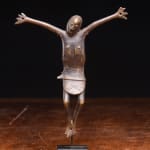Bakongo Christian crucifix "Nkangi Kiditu" made of Brass aloy, DRC
19th Century or earlier
Metal
17 x 14 x 1 cm
6 3/4 x 5 1/2 x 3/8 in
6 3/4 x 5 1/2 x 3/8 in
Further images
-
(View a larger image of thumbnail 1
)

-
(View a larger image of thumbnail 2
)

-
(View a larger image of thumbnail 3
)

-
(View a larger image of thumbnail 4
)

-
(View a larger image of thumbnail 5
)

-
(View a larger image of thumbnail 6
)

-
(View a larger image of thumbnail 7
)

-
(View a larger image of thumbnail 8
)

This crucifix, cast in solid bronze, is known as a Nkangi Kiditu, qui signifie « Christ protecteur », and is from the Kongo people of the Congo. Christ is portrayed...
This crucifix, cast in solid bronze, is known as a Nkangi Kiditu, qui signifie « Christ protecteur », and is from the Kongo people of the Congo. Christ is portrayed with his head inclined to the left, his eyes closed and his mouth shut. The right ankle over the left, with a small loin cloth cast, the nipples marked and with radiating geometric patterns to denote his ribs and hair. The Christ figure is stylized, the face severely abstracted and hands and feet treated as fanlike forms.The Portuguese presence in the coastal regions of west Africa in the 15th and 16th centuries saw the local tribal people absorb European influence. The Kingdom of Kongo, founded in the 14th century, has some of the earliest Christian influence in sub-Saharan Africa. The conversion to Christianity in 1512 of King Alfoso I of the Kongo saw the subsequent creation by Kongolese bronze casters of Christian crucifixes and images of the Virgin Mary and St Anthony after Portuguese prototypes. In time, the local form of Christianity blurred increasingly with traditional beliefs and Christian symbols became emblems of power and instruments in local ritual. The Musee du Quai Branly Jacques Chirac in Paris held an exhibition on Christian-related art from the Congo in 2017. A catalogue Du Jordain au Congo: Art et Christianisme en Afrique Centrale, was published in association with the exhibition







